Master Cold Therapy: Techniques, Benefits, and Safety Insights
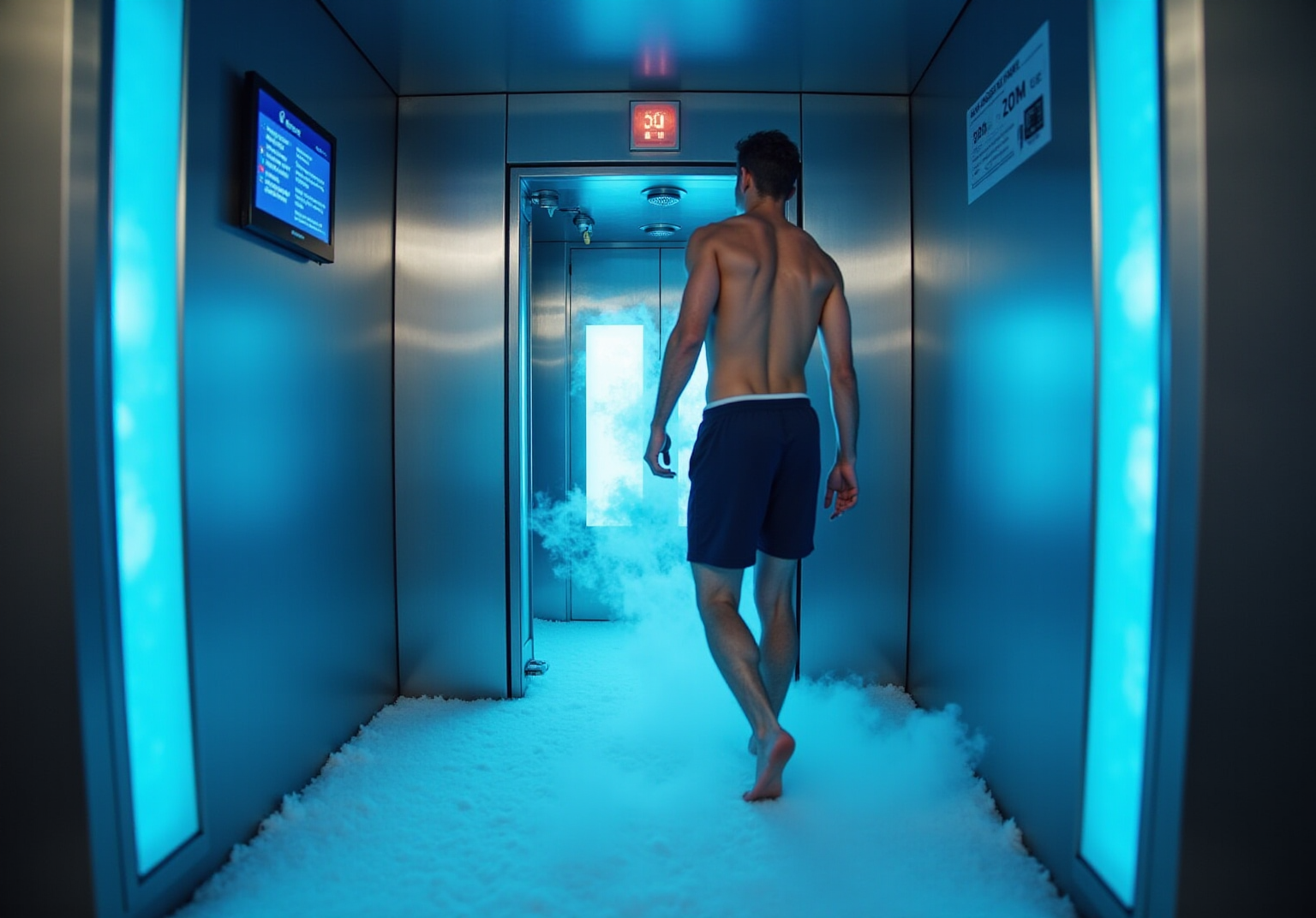
Overview
Cold therapy, also known as cryotherapy, is a highly effective therapeutic technique that harnesses low temperatures to reduce inflammation, alleviate pain, and expedite recovery from injuries. This article explores its mechanisms—such as vasoconstriction and nerve numbing—while detailing various methods of application. The benefits of cold therapy are particularly pronounced for athletes and individuals seeking enhanced recovery. Importantly, safety precautions and individualized treatment strategies are emphasized, ensuring that practitioners can maximize the effectiveness of this innovative approach.
Introduction
Cold therapy, commonly known as cryotherapy, has emerged as a potent method for enhancing recovery and managing pain, capturing the attention of both athletes and health enthusiasts. Its capacity to reduce inflammation, alleviate discomfort, and accelerate healing positions it as an essential tool for wellness. By comprehensively understanding the various techniques and benefits of cold therapy, individuals can unlock new avenues for improved health.
However, as with any treatment, questions regarding safety and effectiveness inevitably arise—particularly concerning when it should be avoided. What key insights can empower individuals to harness the full potential of cold therapy while ensuring their safety?
Define Cold Therapy: Understanding Its Purpose and Mechanisms
Cold therapy, commonly known as cryotherapy, utilizes low temperatures to deliver significant health benefits, primarily aimed at reducing inflammation, alleviating pain, and facilitating recovery from injuries. At Tsavo Wellness, our state-of-the-art whole body cryotherapy chamber, the Cryo Arctic, operates at temperatures as low as minus 140 degrees Celsius, creating a comfortable and effective environment for pain management and rehabilitation. The fundamental processes of cryotherapy are crucial for its effective application in recovery protocols.
Key Mechanisms of Cold Therapy:
- Vasoconstriction: This process effectively reduces blood flow to the affected area, minimizing swelling and inflammation. Research indicates that cold application can significantly decrease the number of inflammatory cells at the injury site, which is essential for managing acute traumas.
- Nerve Numbing: Cold therapy numbs nerve endings, providing immediate pain relief. This effect is particularly beneficial for acute soft-tissue injuries, where cold therapy is vital for prompt pain management.
- Metabolic Rate Reduction: Cold therapy helps limit tissue damage during acute trauma by slowing cellular metabolism. This decrease in metabolic activity is crucial for preserving tissue integrity and fostering a more conducive healing environment.
Real-world applications of cold therapy demonstrate its effectiveness in injury rehabilitation. For instance, athletes frequently employ cold therapy techniques like cool water immersion post-exercise to alleviate muscle soreness and expedite recovery. A study published in The Cochrane Library underscored that cold therapy, including cold baths, can prevent delayed onset muscle soreness (DOMS) compared to resting, though researchers cautioned about potential side effects.
At Tsavo Wellness, we also offer advanced red light therapy, which complements our cryotherapy services. This treatment utilizes red and near-infrared light to address injuries, relieve pain, and enhance overall wellbeing. Our pricing for these treatments includes:
- 3 x Red Light Sessions for $225.00
- 5 x Red Light Sessions for $345.00
- 10 x Red Light Sessions for $649.99
For cryotherapy, the packages are:
- 3 x Cryotherapy Pack for $260.00
- 5 x Cryotherapy Pack for $399.00
- 10 x Cryotherapy Pack for $750.00
Physiotherapists emphasize the importance of discerning when to apply cold therapy. As one specialist noted, 'Understanding when to apply cold therapy and when to apply heat treatment will greatly enhance the effectiveness of the intervention.' This insight highlights the necessity of customizing recovery strategies to individual needs and injury types, ensuring optimal rehabilitation outcomes.
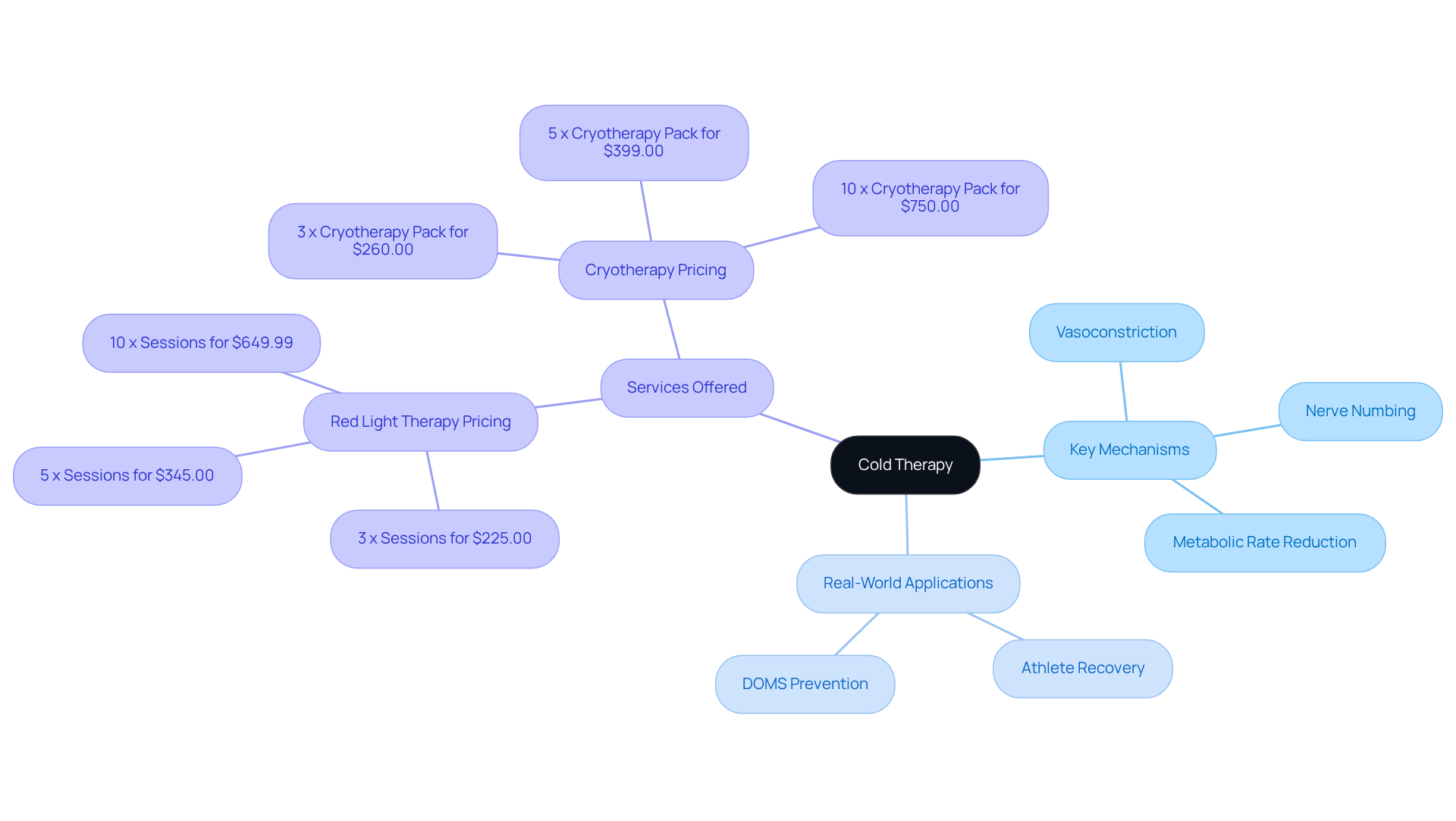
Explore Cold Therapy Techniques: Methods and Applications
Cold therapy includes a variety of methods, each specifically designed for unique applications and benefits. Understanding these techniques is essential for maximizing their effectiveness in promoting recovery and wellness.
-
Ice Packs represent a straightforward yet highly effective approach. By applying ice packs directly to the affected area for 15-20 minutes, one can significantly reduce swelling and pain. This method, cold therapy, is widely endorsed by sports medicine professionals for its immediate analgesic effects, making it a go-to solution for acute injuries.
-
Chilled Compresses offer another viable option. Utilizing a fabric immersed in cool water or a commercially available chilly pack provides localized cooling, effectively relieving discomfort in targeted areas.
-
Ice Baths are particularly favored among athletes. Immersing the body in ice-cold water post-exercise helps alleviate muscle soreness and inflammation. Research indicates that cold therapy, including chilled water immersion, enhances recuperation by promoting blood circulation and minimizing muscle injury, making it a critical component of athletic recovery.
-
Cryotherapy Chambers take cold therapy a step further. These specialized machines expose the body to extremely low temperatures for brief periods, facilitating systemic recovery and pain relief. Cold therapy has gained traction in sports medicine, with practitioners noting its effectiveness in accelerating healing processes and enhancing overall performance.
-
Cold Showers present a more accessible alternative. They invigorate the body and enhance circulation while offering several benefits associated with cold treatment.
-
Mild Hyperbaric Oxygen Therapy at Tsavo Wellness is an innovative therapy that enhances the body's healing processes by increasing oxygen supply to cells and tissues by up to 50%. This method is recognized for its ability to reduce fatigue, expedite injury healing, and strengthen the immune system. A single session lasts 60-90 minutes at an atmospheric pressure of 1.3ATA, providing benefits comparable to consuming 60 liters of hydrogen-infused water, thus making it a valuable addition to any wellness routine.
Application Tips: Always protect the skin with a cloth when applying ice directly to prevent frostbite. Additionally, limit exposure to low temperatures to avoid adverse effects, particularly in sensitive areas.
Integrating these methods into a wellness regimen can yield substantial advantages, including decreased inflammation and enhanced recuperation periods. Cold therapy serves as a beneficial resource for both athletes and health-conscious individuals alike, promoting optimal recovery and performance.
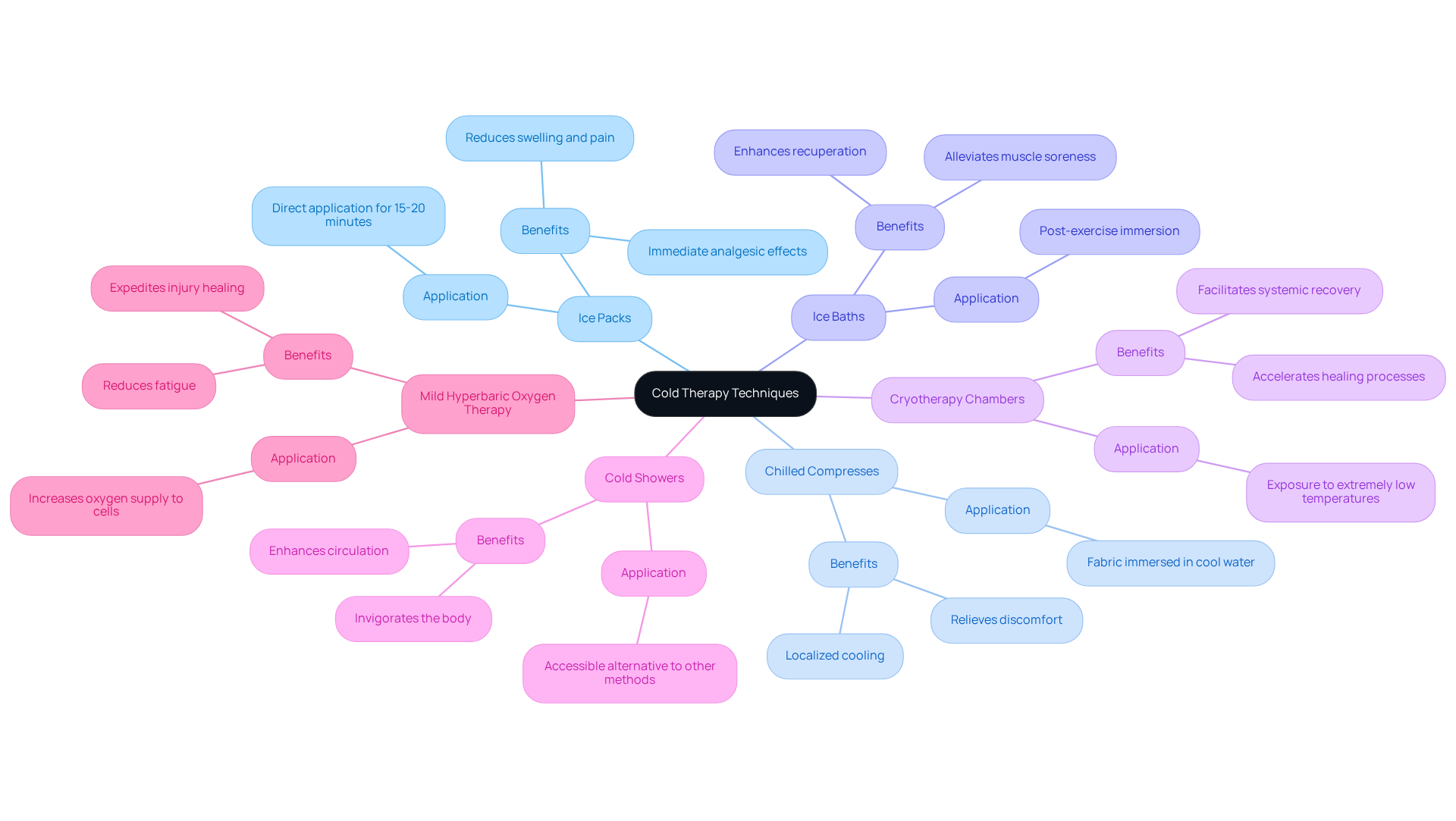
Examine the Benefits of Cold Therapy: Recovery, Pain Relief, and Inflammation Reduction
Cold therapy offers a multitude of advantages that can significantly enhance recovery and overall health, especially when paired with advanced interventions like lymphatic massage and red light techniques available at Tsavo Wellness. Here are some key benefits:
-
Cold therapy is an effective treatment for pain alleviation, as it numbs discomfort and is preferred for both acute ailments and chronic pain conditions. Research indicates that icing can restrict blood circulation, inhibit nerve signaling, and reduce swelling, providing immediate relief after trauma.
-
Inflammation reduction is achieved through cold therapy, which constricts blood vessels and diminishes swelling and inflammation, particularly beneficial following injuries or surgeries. This process aids in stabilizing the affected area, preventing further damage and fostering healing.
-
Cold therapy can be beneficial for recovery. Accelerated Recovery: Athletes often utilize cold therapy treatments to hasten recovery times, allowing them to return to training and competition more swiftly. Studies demonstrate that cold-water immersion mitigates exercise-induced muscle damage, resulting in reduced inflammation and soreness post intense physical activities. At Tsavo Wellness, our rejuvenation solutions, including the Slimyonik Air Bodystyler, enhance lymphatic drainage and promote overall healing through improved circulation and toxin elimination, complementing cold therapy.
Cold therapy is an effective method for pain relief. Enhanced circulation can be achieved by alternating between cold therapy and warm therapies, which invigorates blood flow and facilitates healing and recovery. Water temperatures between 0 and 60 degrees Fahrenheit are considered low-risk during immersion, providing a safe method for enhancing circulation.
Cold therapy can be an effective method for reducing inflammation. Cold therapy has been associated with improved mood and mental clarity, likely due to the release of endorphins and adrenaline. A five-minute immersion in cold water has been shown to elevate feelings of alertness and attentiveness in a study involving adults, contributing to overall well-being. This principle aligns with our holistic approach at Tsavo Wellness, where we emphasize supporting the body as an integrated system.
Summary of Benefits:
- Pain relief and inflammation reduction.
- Accelerated recovery times for athletes, enhanced by our recovery solutions.
- Improved mood and mental clarity.
Cold therapy, including cold compression treatment, aids in stabilizing the affected area and preventing additional injury.
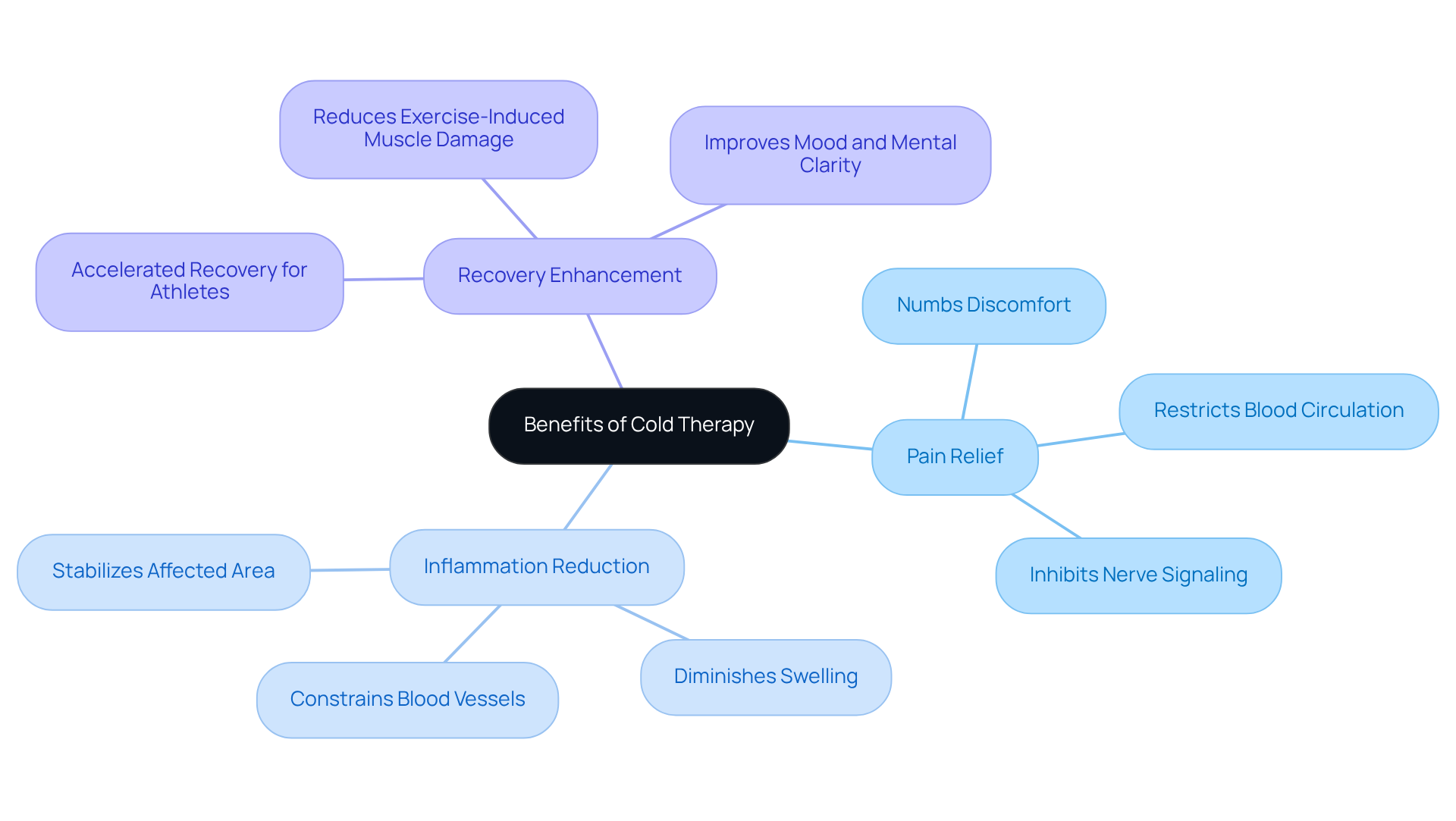
Understand Safety and Precautions: When to Avoid Cold Therapy
While cold therapy offers significant benefits, it is crucial to recognize situations where it should be avoided. Key safety considerations include:
- Circulatory Problems: Individuals with conditions such as Raynaud's disease or peripheral vascular disease must avoid chilly treatments, as these can worsen symptoms and lead to complications.
- Exposed Injuries: Applying cool treatment to exposed injuries can impede recovery and elevate the risk of infection, making it essential to protect these areas.
- Chill Sensitivity: Those with low-temperature intolerance or specific neurological disorders should refrain from using chill treatment, as their bodies may not respond favorably to temperature changes.
- Prolonged exposure during cold therapy sessions must not exceed 20 minutes to prevent frostbite or skin damage, as extended exposure can result in serious tissue injury.
- Consultation with Healthcare Providers: It is advisable to consult a healthcare expert prior to initiating cryotherapy, particularly for individuals with pre-existing health conditions.
In addition to cold therapy, Tsavo Wellness offers gentle hyperbaric oxygen sessions that enhance the body's healing processes and promote overall wellness. This non-invasive treatment increases oxygen delivery to cells and tissues, facilitating recovery, alleviating fatigue, and bolstering the immune system. For those exploring alternative wellness therapies, the AirPod mHBOT at Tsavo Wellness presents a safe and effective complement to cold treatments, ensuring a holistic approach to health and wellbeing.
Safety Tips:
- Regularly monitor the skin condition during application to detect any adverse reactions.
- Always use a barrier, such as a towel, between the ice and skin to minimize the risk of frostbite.
- Limit therapy sessions to avoid potential negative effects, ensuring a safe and effective experience.
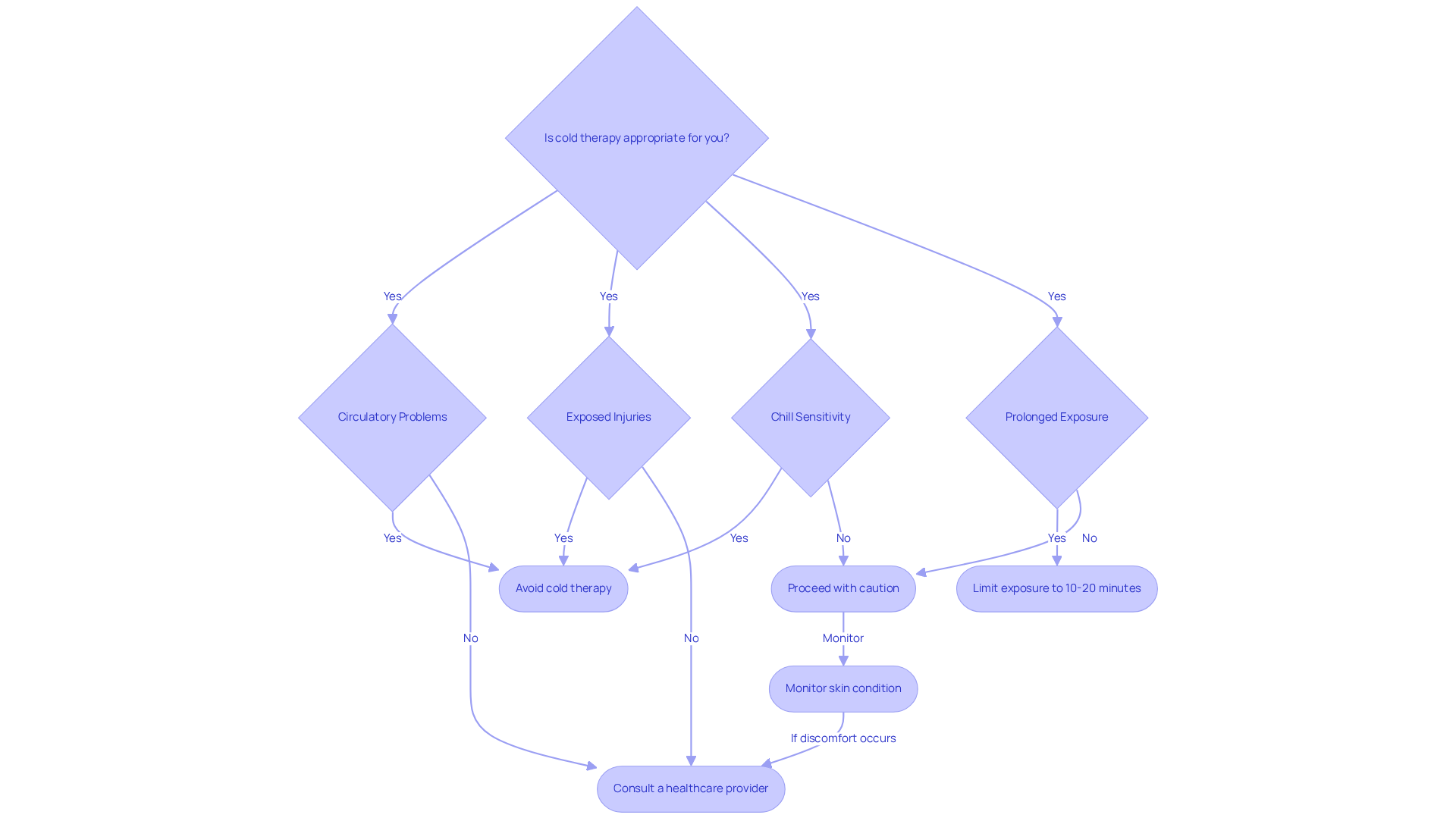
Conclusion
Cold therapy, or cryotherapy, stands as a formidable ally in enhancing recovery, alleviating pain, and managing inflammation. By leveraging the benefits of low temperatures, individuals can achieve remarkable improvements in their overall health and well-being. The techniques detailed herein, ranging from ice packs to advanced cryotherapy chambers, offer a spectrum of options tailored to meet diverse needs and conditions.
Key mechanisms of cold therapy, such as vasoconstriction and nerve numbing, underscore its efficacy in pain management and injury recovery. Real-world applications, particularly among athletes, demonstrate the advantages of cold therapy in accelerating recuperation and diminishing muscle soreness. Moreover, the significance of safety precautions is paramount; understanding when to apply cold therapy and recognizing contraindications is crucial for maximizing its benefits while mitigating risks.
Integrating cold therapy into a holistic wellness strategy can yield transformative health outcomes. Whether one is an athlete pursuing expedited recovery or an individual grappling with chronic pain, incorporating these techniques into daily routines can profoundly enhance quality of life. Dedicating time to explore and implement cold therapy methods not only bolsters physical health but also fosters improved mental clarity and overall vitality.
Frequently Asked Questions
What is cold therapy?
Cold therapy, also known as cryotherapy, uses low temperatures to provide health benefits such as reducing inflammation, alleviating pain, and aiding recovery from injuries.
How does cryotherapy work?
Cryotherapy works through several key mechanisms: - Vasoconstriction reduces blood flow to the affected area, minimizing swelling and inflammation. - Nerve Numbing numbs nerve endings, providing immediate pain relief. - Metabolic Rate Reduction slows cellular metabolism, helping to limit tissue damage during acute trauma.
What are the benefits of using cold therapy for injuries?
Cold therapy is effective in injury rehabilitation by reducing inflammation, numbing pain, and preserving tissue integrity, which fosters a better healing environment.
How do athletes use cold therapy?
Athletes often use cold therapy techniques, such as cool water immersion after exercise, to alleviate muscle soreness and speed up recovery.
What does research say about cold therapy?
A study published in The Cochrane Library found that cold therapy, including cold baths, can prevent delayed onset muscle soreness (DOMS) compared to resting, though there may be potential side effects.
What additional services does Tsavo Wellness offer alongside cryotherapy?
Tsavo Wellness offers advanced red light therapy, which utilizes red and near-infrared light to address injuries, relieve pain, and enhance overall wellbeing.
What are the pricing packages for cryotherapy at Tsavo Wellness?
The pricing for cryotherapy packages at Tsavo Wellness is as follows: - 3 x Cryotherapy Pack for $260.00 - 5 x Cryotherapy Pack for $399.00 - 10 x Cryotherapy Pack for $750.00
What are the pricing packages for red light therapy at Tsavo Wellness?
The pricing for red light therapy sessions at Tsavo Wellness is as follows: - 3 x Red Light Sessions for $225.00 - 5 x Red Light Sessions for $345.00 - 10 x Red Light Sessions for $649.99
Why is it important to know when to apply cold therapy?
Understanding when to apply cold therapy versus heat treatment is crucial for enhancing the effectiveness of the intervention and customizing recovery strategies to individual needs and injury types.


